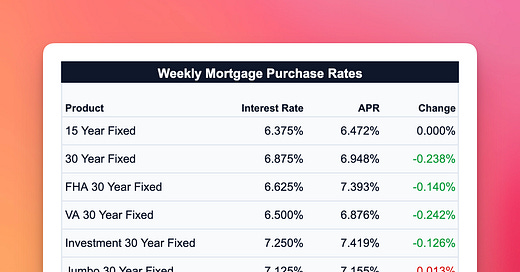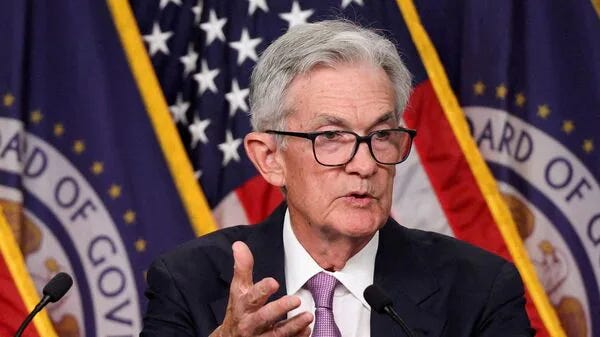Markets Stay Cool - Nov 11 - Weekly Mortgage Update
Markets stayed surprisingly steady this week despite big political and Fed news, showing they're getting better at handling major events.
Request a Quote
A complete workup of your payment and closing costs on any home purchase or existing mortgage refinance. (no credit checks, Texas-only)
⭐️ Check This Out
October saw a modest rise of 12,000 jobs, with weather and labor disputes weighing heavily. Meanwhile, unemployment remained steady at 4.1%.
Housing inventory climbs for the 12th straight month, but homes are taking their sweet time selling.
September’s 0.02% home price rise is proof the market’s alive—just barely. But hey, even a snail gets where it’s going eventually. 🐌
Fed’s latest rate cut: a small nudge that screams, “We’re serious about inflation… but not too serious, don’t panic.”
📊 Market Update
If you've been watching the markets this week (who hasn’t?), you've witnessed something remarkable: a masterclass in how markets process major events. Political expectations, Federal Reserve policy, and market psychology all converged in a way that challenged conventional wisdom. The story that emerged deserves some unpacking.
Here's the deal: Grab your favorite cup of coffee and settle into a comfortable seat, because we're about to break down one of the most eventful weeks in recent market history – nice and easy, as always.
The Election Drama
Let's start with what everyone was watching: the election. Remember how markets hate uncertainty? Well, they apparently hate it so much that they decided to price in their expectations before the actual event. Think of it as the market's version of preparing for a party – setting up all the decorations before knowing exactly how many guests will show up.
The 10-year Treasury yield had been camping out around 4.27-4.28% last week. But as election odds shifted, we saw some serious movement. Why? Because markets were determined not to get caught flat-footed like they did in 2016.
TL;DR: Markets were pricing in their best guess of election outcomes before the actual event.
The Post-Election Reality Check
After the initial election-night volatility (because of course there was volatility), something fascinating happened: the market basically said, "Oh, we pretty much nailed it." The 10-year yield, after some dramatic moves, settled right back around... wait for it... 4.27%.
In other words, traders had done such a good job pricing in their expectations that when the actual news hit, there wasn't much left to do. It's like watching the 12th Friday the 13th movie – sure, Jason's going to jump out, but you're not exactly spilling your popcorn anymore.
The Fed Has Entered the Chat
Just to keep things spicy, the Fed decided to join the party with their latest announcement. Let's face it – in any other week, this would have been the main event. But sandwiched between an election and its aftermath, it almost felt like an afterthought. Almost.
The Fed delivered its anticipated 0.25% rate cut, but the real story was in the details:
They noted labor market conditions have "generally eased"
They dropped their previous language about needing "greater confidence" in inflation moving toward 2%
Powell stood firm on his independence when asked about political pressure
Thing is, the market's reaction was surprisingly muted. After watching yields sprint up and down for days around the election, bonds settled into something resembling a contemplative pause. And why not? Consider the sequence: markets had just digested a major election, repriced their expectations, and were now facing a Fed announcement that basically confirmed what everyone already knew.
But here's what makes this particularly interesting: even when Powell delivered what could have been market-moving comments about the recent run-up in rates "being nowhere near where it was a year ago," bonds barely flinched. When's the last time you saw the market shrug off Fed chair comments like that?
This wasn't your typical post-Fed sleepy trading session where markets just go through the motions. This was markets showing a remarkable level of maturity in processing information.
What This Means Going Forward
Bottom line: we're seeing a market that's increasingly sophisticated in how it prices in major events. This sophistication might actually lead to more stability in the long run. Why? Because when expectations are properly priced in, the actual events tend to create less volatility.
Put simply:
Markets are getting better at anticipating political outcomes
Economic data still matters, perhaps more than ever
The Fed remains focused on its mandate, regardless of political noise
Long-term rates might be finding their comfort zone
Later This Week
Tuesday, Nov 12
Fed Waller: Speech by Federal Reserve Governor Christopher Waller
Fed Kashkari: Speech by Federal Reserve Bank of Minneapolis President Neel Kashkari
Fed Harker: Speech by Federal Reserve Bank of Philadelphia President Patrick Harker
Wednesday, Nov 13
Core CPI: Core Consumer Price Index report
CPI: Consumer Price Index report
Thursday, Nov 14
Jobless Claims: Weekly unemployment insurance claims report
Fed Williams: Speech by Federal Reserve Bank of New York President John Williams
Friday, Nov 15
Retail Sales: Monthly report on consumer spending at retail establishments







